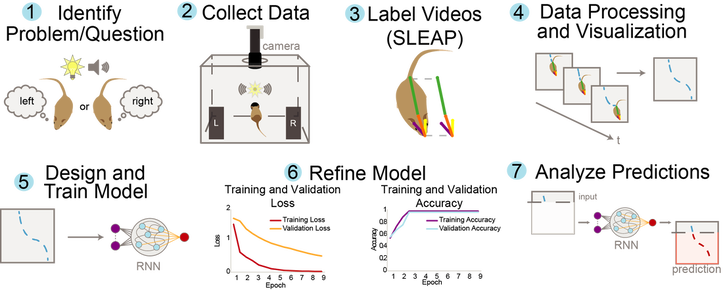OUR APPROACH
HOW DOES THE BRAIN INTEGRATE SENSORY INFORMATION TO GUIDE OUR BEHAVIOR?
Consider walking on a loud and busy street and suddenly hearing heavy footsteps approaching behind you. Deciding whether to turn or move out of the way to avoid collision becomes more evident with the sound of each added step. This ability of integrating sensory observations over time (“temporal integration”) is fundamental for guiding perceptual decisions.
Perceptual decision-making has been studied at the level of stimulus representations in sensory cortex, and in higher cortical areas that are thought to produce premotor decision-related signals. However, the transition between these two neural representations remains mysterious. Are the neural representations of decision-related variables casually related to the temporal integration of sensory input? We hypothesize that neural representations of sensory information transform across the ascending pathway, ultimately corresponding with perceptual judgements. By studying the neural circuit activity involved in the temporal integration of sensory inputs, our research program aims to understand how transformations of sensory information across higher cortical areas support perceptual decision-making.
Perceptual decision-making has been studied at the level of stimulus representations in sensory cortex, and in higher cortical areas that are thought to produce premotor decision-related signals. However, the transition between these two neural representations remains mysterious. Are the neural representations of decision-related variables casually related to the temporal integration of sensory input? We hypothesize that neural representations of sensory information transform across the ascending pathway, ultimately corresponding with perceptual judgements. By studying the neural circuit activity involved in the temporal integration of sensory inputs, our research program aims to understand how transformations of sensory information across higher cortical areas support perceptual decision-making.
HOW DOES THE BRAIN TEMPORALLY INTEGRATE MULTISENSORY INFORMATION?
The decisions that guide our daily behaviors require integrating information across time and multiple sensory modalities. Currently, perceptual decision-making has typically been examined through unisensory paradigms. Thus, the neural network responsible for perceptual decisions based on the temporal integration of multisensory inputs remains uncertain. This line of research will reveal the transformations of multisensory representations across higher cortical areas that guide perceptual decision-making.
To further quantify temporal integration, we are developing machine learning models to classify trial outcomes based on limited video- tracking information. We will implement additional algorithms to determine the timescale at which animals successfully integrate sensory signals to guide their perceptual judgements.
To further quantify temporal integration, we are developing machine learning models to classify trial outcomes based on limited video- tracking information. We will implement additional algorithms to determine the timescale at which animals successfully integrate sensory signals to guide their perceptual judgements.
WHAT ARE THE NEURAL MECHANISMS THAT LINK HEARING LOSS AND COGNITIVE DEFICITS?
Emerging work suggests that hearing loss is associated with the cognitive impairments that develop during aging. Thus, hearing loss could be a potential risk factor for age-related neurogenerative diseases, such as Dementia and Alzheimer's Disease. Understanding the neural basis that links hearing loss with cognitive decline presents unprecedented opportunities for targeted intervention of hearing loss to treat and prevent cognitive decline.

